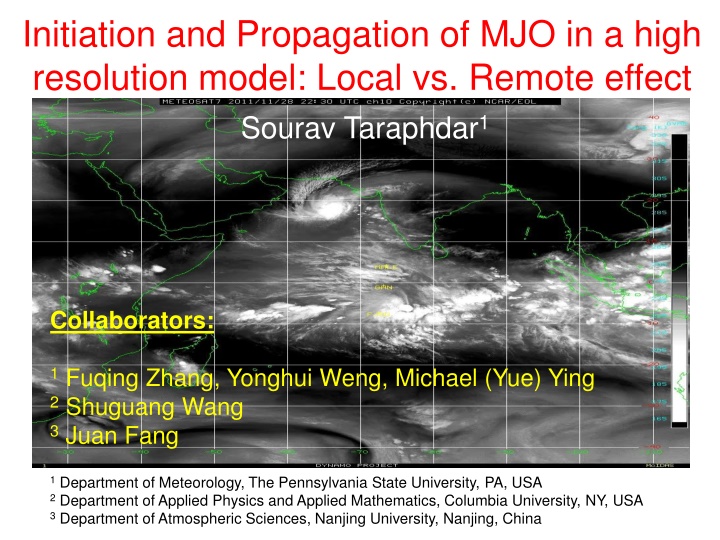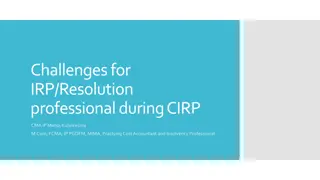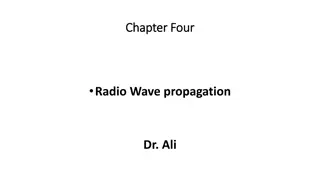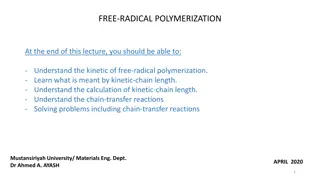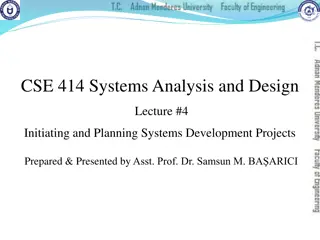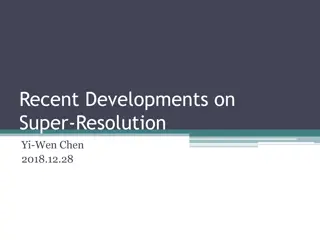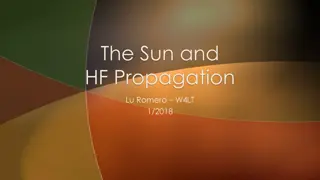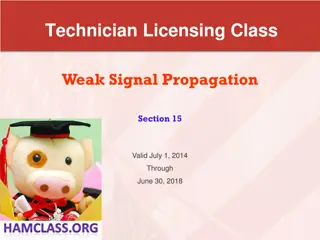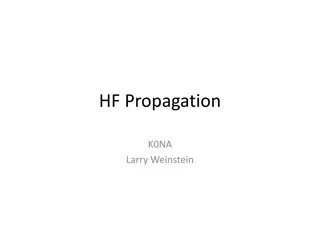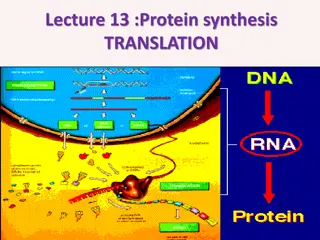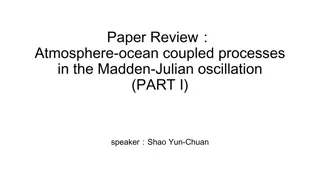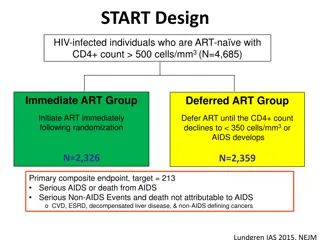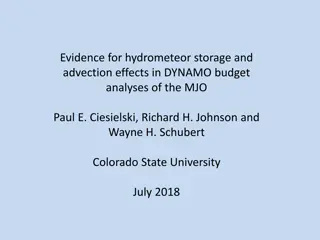Dynamics of MJO Initiation and Propagation in High-Resolution Model
Study focuses on MJO initiation over the Western Indian Ocean, with insights into moisture dynamics for eastward propagation using a high-resolution model. Role of equatorial Rossby and Kelvin waves in preconditioning for MJO propagation is investigated through experiments with waves separation techniques.
Download Presentation

Please find below an Image/Link to download the presentation.
The content on the website is provided AS IS for your information and personal use only. It may not be sold, licensed, or shared on other websites without obtaining consent from the author.If you encounter any issues during the download, it is possible that the publisher has removed the file from their server.
You are allowed to download the files provided on this website for personal or commercial use, subject to the condition that they are used lawfully. All files are the property of their respective owners.
The content on the website is provided AS IS for your information and personal use only. It may not be sold, licensed, or shared on other websites without obtaining consent from the author.
E N D
Presentation Transcript
Initiation and Propagation of MJO in a high resolution model: Local vs. Remote effect Sourav Taraphdar1 Collaborators: 1 Fuqing Zhang, Yonghui Weng, Michael (Yue) Ying 2 Shuguang Wang 3 Juan Fang 1 Department of Meteorology, The Pennsylvania State University, PA, USA 2 Department of Applied Physics and Applied Mathematics, Columbia University, NY, USA 3 Department of Atmospheric Sciences, Nanjing University, Nanjing, China
How MJO is initiated over western Indian Ocean (WIO)? Circumnavigation of a proceeding MJO event that travels around the global tropics (Lau & Peng, 1987; Wang and Li, 1994; Seo and Kim, 2003; Matthews 2008) Local tropical forcing's in addition to extratropical forcing's (Ray et al., 2009; Zhao et al., 2013) A marked increase of low level moisture in association with warmer temperature and anomalous ascending motion appeared 5 10 days prior to the convection initiation Increase of moisture was caused primarily by the horizontal advection of the mean specific humidity by anomalous flows induced due to downstream Rossby wave response to a preceding suppressed phase MJO over the eastern IO
Moisture dynamics responsible for the eastward propagation of MJO (Hsu and Li, 2012; Li 2014) A positive moisture anomaly appears at the PBL (1000 700 hPa) to the east of the MJO convection Mid tropospheric heating associated with MJO convection induces a baroclinic free atmosphere response, with Kelvin (Rossby) wave response to the east (west) of convection center Anomalous low pressure at the top of PBL associated with Kelvin wave response may induce a convergence in the boundary layer, while PBL divergence may occur to the west between two Rossby wave gyres Warm SST anomaly to the east of the convection helps to trigger a fresh convection to the east of the current convection Hsu and Li, 2012
What primarily causes MJO initiation ? is it causes by local effects and/or circumnavigating signals (remote effects)? What are the role of equatorial Rossby waves and Kelvin waves in preconditioning the IO for MJO propagation using high resolution model with waves separation techniques? Control Simulation: WRF model at 9km horizontal resolution following the experimental design of Wang et al., (2015) Experimental design: Identify the MJO signals into the forcing's data sets Experiment 1: Removes MJO related signals only from initial condition Experiment 2: Similar to 1 but removes MJO from boundary conditions Experiment 3: Removes both from initial and boundary conditions Events: Oct 2013 during DYNAMO/CINDY 2013 field campaign ERA-Interim is adopted to construct initial, bottom and lateral boundary conditions for regional simulations Model simulations start from 1 Oct 2013, with spectral nudging of horizontal winds for the first 3 days
Hovmoller diagram of daily rainfall from TRMM and WRF clearly shows the MJO event, starting from ~60E and propagating eastward Eastward propagation of precipitation is disrupted near the Maritime Continents (100o E) in both model and observation Rainfall associated with MJO is not collocated with the westerly wind maximum but occurs mostly in the leading edge of the westerly regime bordering the easterlies
Large scale precipitation maxima migrate northward slowly Precipitation generally coincides with low level cyclonic relative vorticity anomalies during the active MJO phases, might evolve into tropical cyclones in some events
Vertical motion in both the model and observation shows the top heavy first baroclinic mode structure during active phases of MJO Changes of westerly to easterly at lower troposphere (600 800 hPa) prior to MJO event, and turns back to westerlies during MJO active phases (late Oct to early Nov) A classical structure of tilted positive temperature anomaly prior to MJO rainfall peak followed by a negative temp anomaly Dryness of lower troposphere during suppressed phases of MJO, followed by gradual lower level moistening prior to MJO event, when low level wind is easterly and temperature anomaly is positive
The Role of Moist Processes in the Intrinsic Predictability of Indian Ocean Cyclone Objective Identify the predictability limit and the mechanism for the error cascades across spatial scales for Indian Ocean tropical cyclones Approach Simulate four tropical cyclones in the Bay of Bengal using WRF v3.4 at 30km, 10km and 1.1km horizontal resolutions Perform identical twin perturbation experiments at the three resolutions to quantify the model errors at each resolution Estimate the predictability using the error doubling time Analyze and elucidate the error cascades across spatial scales using different techniques such as power spectrum and scale separation and using numerical experiments Error growth starts from the region of convection on Day 1 and cascades to significant larger scale errors on Day 4 Impact Found that buoyancy associated with moist convection plays a major role in intrinsic error growth that limits the intrinsic predictability of tropical cyclones Demonstrated that errors start to build up from regions of convection and ultimately affects the larger scales through upscale cascades of errors Taraphdar, S., P. Mukhopadhyay, L. R. Leung, F. Zhang, S. Abhilash and B.N. Goswami. 2014. The role of moist processes in the intrinsic predictability of Indian ocean cyclone , J. Geophys. Res. Atmos., 119, 8032 8048, doi:10.1002/2013JD021265. 8
Cyclone-Cyclone Interactions through the Ocean Pathway Objective Study how the lingering cold wake from one tropical cyclone may influence the intensity of a later cyclone that passes over the cold wake Systematically quantify the frequency and impacts of these cyclone-cyclone interactions on mean cyclone intensification rates in the three most active cyclone basins Interaction of cyclones Katia and Maria in the North Atlantic (September 2011). The SST cooling (oC) induced by Katia is shown in the background with the tracks of cyclones Katia and Maria overlaid. Approach Performed data analysis and numerical modeling of two cyclones, Katia and Maria, as a representative case study of cyclone- cyclone interactions in the North Atlantic Analyzed observational data from 1984 2011 to quantify the frequency of occurrence of cyclone-cyclone interactions and their impacts on basin mean cyclone intensification rates in the North Atlantic, eastern Pacific, and northwestern Pacific Impact Cyclones have, on average, 10% chance to interact with wakes and such interactions reduce the mean intensification rates for cyclones by 3% 6% on average, and by 12% 15% during the most active years Identified and quantified Cyclone-cyclone interactions as a mechanism through which tropical cyclones may self-regulate their activity to an extent on intraseasonal time scales, with potential implications for future cyclone activities in a warmer climate. Balaguru K, S Taraphdar, LR Leung, GR Foltz, and JA Knaff. 2014. Cyclone-cyclone Interactions through the Ocean Pathway. Geophys. Res. Lett., 41, 6855 6862. DOI:10.1002/2014GL061489. 9
Linkage of remote SST and Atlantic tropical cyclone activity mediated by the African monsoon Strong minus weak monsoon years A. NOAA OISST B. NCEP 700hPA Wind Objective Systematically analyze the relationship between North Atlantic & Mediterranean (NAMED) SST and Atlantic Hurricane activity through their linkages to the African monsoon rainfall (AMR) C. NCEP MSE (KJ/Kg) Approach Analyzed several observational data for a 30-years (1984 - 2013) period including NHC TC track data, NOAA OI and UKMO Had SST, ERA and NCEP reanalysis data set Establish the dynamical linkages and statistical relationships Total Hurricane Tropical Storms Composite spatial distribution of A. NOAA OISST (deg C), B. 700hPa Wind (m/s), C. Lower level MSE (KJ/Kg) between strong and weak monsoon years. Panel D depicts the distribution of all storms (blue) including hurricanes (brown) and tropical storms (green) under different SST conditions Impact Warmer NAMED SST is positively linked to hurricane frequency east of 45W through its influence on AMRs activity, with more prominent correlation in the latter half of summer (August, September) NAMED SST can explains about 8% on interannual variability of Atlantic TC Frequency Taraphdar, S., LR. Leung and Samson Hagos. 2015 Linkage of remote Sea surface temperatures and Atlantic tropical cyclone activity mediated by the African monsoon , Geophys. Res. Lett., 42, 572 578, doi:10.1002/2014GL062600. 10
